Scientometric Insights into Rechargeable Solid-State Battery Developments
Abstract
:1. Introduction
2. Literature Review
2.1. Rechargeable Battery Primer
2.1.1. Basic Operation
2.1.2. Anode Material
2.1.3. Cathode Material
2.1.4. Electrolyte Material
2.2. Solid-State Designs
2.3. Active Research Areas
2.3.1. Electrolyte
2.3.2. Anode
2.3.3. Cathode
2.3.4. Interfacial Integrity
2.3.5. Battery Pack Development
3. Methodology
4. Results
4.1. SME Categorization
4.2. Thematic Analysis
4.3. Bibliometric Analysis
5. Discussion of Key Findings
5.1. Ionic Conductivity
5.2. Interfacial Resistance
5.3. Cycling Stability
5.4. Energy Density
5.5. Manufacturability
5.6. Limitations and Future Works
6. Conclusions
Funding
Data Availability Statement
Conflicts of Interest
References
- Thomas, C.M.; Zeng, D.; Huang, H.C.; Pham, T.; Torres-Castanedo, C.G.; Bedzyk, M.J.; Dravid, V.P.; Hersam, M.C. Earth-Abundant Kaolinite Nanoplatelet Gel Electrolytes for Solid-State Lithium Metal Batteries. ACS Appl. Mater. Interfaces 2024, 16, 34913. [Google Scholar] [CrossRef] [PubMed]
- Kumar, S.; Chakravarty, K.; Kumar, K.; Sen, A.; Ghanty, C.; Chakravarty, S.; Kundu, R. Solid-State Direct Regeneration of Spent Lithium Cobalt Oxide Cathodes for Li-Ion Batteries. Energy Fuels 2024, 38, 6499. [Google Scholar] [CrossRef]
- Abe, A.; Mori, D.; Wang, Z.; Taminato, S.; Takeda, Y.; Yamamoto, O.; Imanishi, N. Flexible High Lithium-Ion Conducting PEO-Based Solid Polymer Electrolyte with Liquid Plasticizers for High Performance Solid-State Lithium Batteries. ChemistryOpen 2024, 13, e202400041. [Google Scholar] [CrossRef] [PubMed]
- Choi, Y.J.; Hwang, Y.J.; Kim, S.-I.; Kwak, M.-J.; Kim, T. Triple-Doped Argyrodite Sulfide Electrolyte with Improved Air Stability and Lithium Compatibility for All-Solid-State Li Metal Batteries. Chem. Eng. J. 2024, 497, 154426. [Google Scholar] [CrossRef]
- Song, Z.; Dai, Y.; Wang, T.; Yu, Q.; Ye, X.; Wang, L.; Zhang, Y.; Wang, S.; Luo, W. An Active Halide Catholyte Boosts the Extra Capacity for All-Solid-State Batteries. Adv. Mater. 2024, 36, 2405277. [Google Scholar] [CrossRef]
- Ding, N.; Chien, S.W.; Tam, T.L.D.; Li, X.; Wu, G.; Lee, W.J.; Chiam, S.Y.; Meng, Y.S.; Fam, D.W.H. Revealing Phase Transitions in Poly(Ethylene Oxide)-Based Electrolyte for Room-Temperature Solid-State Batteries. Adv. Energy Mater. 2024, 14, 2402986. [Google Scholar] [CrossRef]
- Kim, H.; Jang, E.; Cho, J.; Pyo, S.; Yun, H.; Lee, J.; Min, B.; Han, J.; Yoo, J.; Kim, Y.S. Strategic Atomic Interaction Modification for Highly Durable Inorganic Solid Electrolytes in Advanced All-Solid-State Li-Metal Batteries. Small Struct. 2024, 5, 9. [Google Scholar] [CrossRef]
- Sung, J.; Lee, H.G.; Jo, Y.-S.; Kim, D.; Park, H.; Park, J.-H.; Kim, D.; Ha, Y.-C.; Baeg, K.-J.; Park, J.-W. Size-Controlled Wet-Chemical Synthesis of Sulfide Superionic Conductors for High-Performance All-Solid-State Batteries. Energy Storage Mater. 2024, 67, 103253. [Google Scholar] [CrossRef]
- Li, J.; Tong, H.; Zhou, W.; Liu, J.; Song, X. Electrochemical Performance and Microstructure Evolution of A Quasi-Solid-State Lithium Battery Prepared By Spark Plasma Sintering. ACS Appl. Mater. Interfaces 2024, 16, 8045. [Google Scholar] [CrossRef]
- Mohammadi, S.J.; Fashandi, S.A.M.; Jafari, S.; Nikolaidis, T. A Scientometric Analysis and Critical Review of Gas Turbine Aero-Engines Control: From Whittle Engine to More-Electric Propulsion. Meas. Control 2021, 54, 935–966. [Google Scholar] [CrossRef]
- Manthiram, A. A Reflection on Lithium-Ion Battery Cathode Chemistry. Nat. Commun. 2020, 11, 1550. [Google Scholar] [CrossRef] [PubMed]
- Huang, W.; Feng, X.; Han, X.; Zhang, W.; Jiang, F. Questions and Answers Relating to Lithium-Ion Battery Safety Issues. Cell Rep. Phys. Sci. 2021, 2, 100285. [Google Scholar] [CrossRef]
- Bridgelall, R. Aircraft Innovation Trends Enabling Advanced Air Mobility. Inventions 2024, 9, 84. [Google Scholar] [CrossRef]
- Wu, B.; Wang, S.; Iv, W.J.E.; Deng, Z.; Yang, J.; Xiao, J. Interfacial Behaviours Between Lithium Ion Conductors and Electrode Materials in Various Battery Systems. J. Mater. Chem. A 2016, 4, 15266. [Google Scholar] [CrossRef]
- Mills, A.; Kalnaus, S.; Tsai, W.-Y.; Su, Y.-F.; Williams, E.; Zheng, X.; Vaidyanathan, S.; Hallinan, D.T., Jr.; Nanda, J.; Yang, G. Elucidating Polymer Binder Entanglement in Freestanding Sulfide Solid-State Electrolyte Membranes. ACS Energy Lett. 2024, 9, 2677–2684. [Google Scholar] [CrossRef]
- York, M.; Larson, K.; Harris, K.C.; Carmona, E.A.; Albertus, P.; Sharma, R.; Noked, M.; Strauss, E.; Ragones, H.; Golodnitsky, D. Recent Advances in Solid-State Beyond Lithium Batteries. J. Solid State Electrochem. 2022, 26, 1851. [Google Scholar] [CrossRef]
- Kumar, P.; Channi, H.K.; Babbar, A.; Kumar, R.; Bhutto, J.K.; Khan, T.M.Y.; Bhowmik, A.; Razak, A.; Wodajo, A.W. A Systematic Review of Nanotechnology for Electric Vehicles Battery. Int. J. Low-Carbon Technol. 2024, 19, 747. [Google Scholar] [CrossRef]
- Pimlott, J.L.; Street, R.J.; Down, M.P.; Banks, C.E. Electrochemical Overview: A Summary of ACoxMnyNizO2 and Metal Oxides as Versatile Cathode Materials for Metal-Ion Batteries. Adv. Funct. Mater. 2021, 31, 2107761. [Google Scholar] [CrossRef]
- Kuang, Y.; Chen, C.; Kirsch, D.J.; Hu, L. Thick Electrode Batteries: Principles, Opportunities, and Challenges. Adv. Energy Mater. 2019, 9, 1901457. [Google Scholar] [CrossRef]
- Liu, H.; Sun, Q.; Zhang, Q.; Cheng, J.; Li, Y.; Zeng, Z.; Zhang, S.; Xu, X.; Ji, F.; Li, D.; et al. The Application Road of Silicon-Based Anode in Lithium-Ion Batteries: From Liquid Electrolyte to Solid-State Electrolyte. Energy Storage Mater. 2023, 55, 244. [Google Scholar] [CrossRef]
- Mageto, T.; Bhoyate, S.; Souza, F.M.D.; Mensah-Darkwa, K.; Kumar, A.; Gupta, R.K. Developing Practical Solid-State Rechargeable Li-Ion Batteries: Concepts, Challenges, and Improvement Strategies. J. Energy Storage 2022, 55, 105688. [Google Scholar] [CrossRef]
- Hu, Z.; Li, J.; Zhang, B.; Zhu, Y. Strategies to Improve the Performance of Li Metal Anode for Rechargeable Batteries. Front. Chem. 2020, 8, 409. [Google Scholar] [CrossRef] [PubMed]
- Kim, M.; Park, J.-W.; Kim, B.G.; Lee, Y.-J.; Ha, Y.-C.; Lee, S.-M.; Baeg, K.-J. Facile Fabrication of Solution-Processed Solid-Electrolytes for High-Energy-Density All-Solid-State-Batteries By Enhanced Interfacial Contact. Sci. Rep. 2020, 10, 11923. [Google Scholar] [CrossRef] [PubMed]
- Xu, N.; Zhang, D.; Wang, M.; Fan, X.; Zhang, T.; Peng, L.; Zhou, X.-D.; Qiao, J. High-Performing Rechargeable/Flexible Zinc-Air Batteries By Coordinated Hierarchical Bi-Metallic Electrocatalyst and Heterostructure Anion Exchange Membrane. Nano Energy 2019, 65, 104021. [Google Scholar] [CrossRef]
- Chen, Z.; Wang, K.; Pei, P.; Zuo, Y.; Wei, M.; Wang, H.; Zhang, P.; Shang, N. Advances in Electrolyte Safety and Stability of Ion Batteries Under Extreme Conditions. Nano Res. 2022, 16, 2311. [Google Scholar] [CrossRef]
- Yu, D.; Min, J.-Y.; Lin, F.; Madsen, L.A. Mechanically and Thermally Robust Gel Electrolytes Built From A Charged Double Helical Polymer. Adv. Mater. 2024, 36, e2312513. [Google Scholar] [CrossRef]
- Shen, H.; Yi, E.; Cheng, L.; Amores, M.; Chen, G.; Sofie, S.W.; Doeff, M.M. Solid-State Electrolyte Considerations for Electric Vehicle Batteries. Sustain. Energy Fuels 2019, 3, 1647. [Google Scholar] [CrossRef]
- Lee, J.-H.; Lee, H.; Lee, J.W.; Kang, T.W.; Park, J.H.; Shin, J.-H.; Lee, H.; Majhi, D.; Lee, S.U.; Kim, J.-H. Multicomponent Covalent Organic Framework Solid Electrolyte Allowing Effective Li-Ion Dissociation and Diffusion for All-Solid-State Batteries. ACS Nano 2023, 17, 17372. [Google Scholar] [CrossRef]
- Singh, D.K.; Fuchs, T.; Krempaszky, C.; Mogwitz, B.; Janek, J. Non-Linear Kinetics of the Lithium Metal Anode on Li6PS5Cl At High Current Density: Dendrite Growth and the Role of Lithium Microstructure on Creep. Adv. Sci. 2023, 10, e2302521. [Google Scholar] [CrossRef]
- Sharma, V.; Singh, K.; Narayanan, K. A Review on Conventional to Bipolar Design of Anode Less All Solid-State Batteries. Energy Adv. 2024, 3, 1222. [Google Scholar] [CrossRef]
- Shi, Z.; Wang, Y.; Yue, X.; Zhao, J.; Fang, M.; Liu, J.; Chen, Y.; Dong, Y.; Yan, X.; Liang, Z. Mechanically Interlocked Interphase with Energy Dissipation and Fast Li-Ion Transport for High-Capacity Lithium Metal Batteries. Adv. Mater. 2024, 36, 2401711. [Google Scholar] [CrossRef] [PubMed]
- Li, W.; Quirk, J.A.; Li, M.; Xia, W.; Morgan, L.M.; Yin, W.; Zheng, M.; Gallington, L.C.; Ren, Y.; Zhu, N.; et al. Precise Tailoring of Lithium-Ion Transport for Ultralong-Cycling Dendrite-Free All-Solid-State Lithium Metal Batteries. Adv. Mater. 2023, 36, 2302647. [Google Scholar] [CrossRef] [PubMed]
- Alexander, G.V.; Shi, C.; O’neill, J.S.; Wachsman, E.D. Extreme Lithium-Metal Cycling Enabled By a Mixed Ion- and Electron-Conducting Garnet Three-Dimensional Architecture. Nat. Mater. 2023, 22, 1136. [Google Scholar] [CrossRef] [PubMed]
- Razali, A.A.; Norazli, S.N.; Sum, W.S.; Yeo, S.Y.; Dolfi, A.; Srinivasan, G. State-of-The-Art of Solid-State Electrolytes on the Road Map of Solid-State Lithium Metal Batteries for E-Mobility. ACS Sustain. Chem. Eng. 2023, 11, 7927. [Google Scholar] [CrossRef]
- Choi, H.J.; Kang, D.W.; Park, J.-W.; Park, J.-H.; Lee, Y.; Ha, Y.-C.; Lee, S.-M.; Yoon, S.Y.; Kim, B.G. In Situ Formed Ag-Li Intermetallic Layer for Stable Cycling of All-Solid-State Lithium Batteries. Adv. Sci. 2021, 9, 2103826. [Google Scholar] [CrossRef] [PubMed]
- Yang, H.; Wu, N. Ionic Conductivity and Ion Transport Mechanisms of Solid-State Lithium-Ion Battery Electrolytes: A Review. Energy Sci. Eng. 2022, 10, 1643. [Google Scholar] [CrossRef]
- Chen, R.; Li, Q.; Yu, X.; Chen, L.; Li, H. Approaching Practically Accessible Solid-State Batteries: Stability Issues Related to Solid Electrolytes and Interfaces. Chem. Rev. 2019, 120, 6820. [Google Scholar] [CrossRef] [PubMed]
- Swathi, P.; Sreejith, O.V.; Panneerselvam, T.; Murugan, R.; Ramaswamy, A.P. Cross-Linked Polymer Composite Electrolyte Incorporated with Waste Seashell Based Nanofiller for Lithium Metal Batteries. Energy Fuels 2023, 37, 6186. [Google Scholar] [CrossRef]
- Li, D.; Liu, H.; Wang, C.; Yan, C.; Zhang, Q.; Nan, C.; Fan, L. High Ionic Conductive, Mechanical Robust Sulfide Solid Electrolyte Films and Interface Design for All-Solid-State Lithium Metal Batteries. Adv. Funct. Mater. 2024, 34, 2315555. [Google Scholar] [CrossRef]
- Zhao, G.; Wang, X.; Negnevitsky, M. Connecting Battery Technologies for Electric Vehicles From Battery Materials to Management. Iscience 2022, 25, 103744. [Google Scholar] [CrossRef] [PubMed]
- Ramasubramanian, B.; Dalapati, G.K.; Reddy, M.V.; Zaghib, K.; Chellappan, V.; Ramakrishna, S. Progress and Complexities in Metal-Air Battery Technology. Energy Technol. 2024, 12, 2301375. [Google Scholar] [CrossRef]
- Lee, J.; Zhao, C.; Wang, C.; Chen, A.; Sun, X.; Amine, K.; Xu, G.-L. Bridging the Gap Between Academic Research and Industrial Development in Advanced All-Solid-State Lithium-Sulfur Batteries. Chem. Soc. Rev. 2024, 53, 5264. [Google Scholar] [CrossRef] [PubMed]
- Huang, C.; Zheng, H.; Qin, N.; Wang, C.; Wang, L.; Lu, J. Single-Crystal Nickel-Rich Cathode Materials: Challenges and Strategies. Acta Phys.-Chim. Sin. 2024, 40, 2308051. [Google Scholar] [CrossRef]
- Ma, Y.; Shang, R.; Liu, Y.; Lake, R.K.; Ozkan, M.; Ozkan, C.S. Enabling Fast-Charging Capability for All-Solid-State Lithium-Ion Batteries. J. Power Sources 2023, 559, 232647. [Google Scholar] [CrossRef]
- Lin, R.; He, Y.; Wang, C.; Zou, P.; Hu, E.; Yang, X.-Q.; Xu, K.; Xin, H.L. Characterization of the Structure and Chemistry of the Solid-Electrolyte Interface By cryo-EM Leads to High-Performance Solid-State Li-Metal Batteries. Nat. Nanotechnol. 2022, 17, 768. [Google Scholar] [CrossRef] [PubMed]
- Wang, C.; Zhao, Y.; Sun, Q.; Li, X.; Liu, Y.; Liang, J.; Li, X.; Lin, X.; Li, R.; Adair, K.R.; et al. Stabilizing Interface Between Li10SnP2S12 and Li Metal By Molecular Layer Deposition. Nano Energy 2018, 53, 168. [Google Scholar] [CrossRef]
- Wang, Y.; Ni, R.; Jiang, X.-Z.; Yin, M.; Zhang, D.; Xie, Z. An Electrochemical-Mechanical Coupled Multi-Scale Modeling Method and Full-Field Stress Distribution of Lithium-Ion Battery. Appl. Energy 2023, 347, 121444. [Google Scholar] [CrossRef]
- Yang, R.; Xie, Y.; Li, K.; Li, W.; Hu, X.; Fan, Y.; Zhang, Y. Thermal Characteristics of Solid-State Battery and Its Thermal Management System Based on Flat Heat Pipe. Appl. Therm. Eng. 2024, 252, 123575. [Google Scholar] [CrossRef]
- Waseem, M.; Ahmad, M.; Parveen, A.; Suhaib, M. Battery Technologies and Functionality of Battery Management System for EVs: Current Status, Key Challenges, and Future Prospectives. J. Power Sources 2023, 580, 233349. [Google Scholar] [CrossRef]
- Iyer, V.; Petersen, J.C.; Geier, S.; Wierach, P. Development and Multifunctional Characterization of A Structural Sodium-Ion Battery Using a High-Tensile-Strength Poly(Ethylene Oxide)-Based Matrix Composite. ACS Appl. Energy Mater. 2024, 7, 3968. [Google Scholar] [CrossRef]
- Bridgelall, R.; Corcoran, M. Conformal Body Capacitors Suitable for Vehicles. U.S. Patent 9,966,790, 8 May 2018. [Google Scholar]
- Eck, N.J.V.; Waltman, L. VOSviewer. Leiden University, 1 July 2024. Available online: https://www.vosviewer.com/ (accessed on 30 June 2024).
- Nam, Y.J.; Oh, D.Y.; Jung, S.H.; Jung, Y.S. Toward Practical All-Solid-State Lithium-Ion Batteries with High Energy Density and Safety: Comparative Study for Electrodes Fabricated by Dry- and Slurry-Mixing Processes. J. Power Sources 2017, 375, 93. [Google Scholar] [CrossRef]
- Yamamoto, M.; Terauchi, Y.; Sakuda, A.; Takahashi, M. Binder-Free Sheet-Type All-Solid-State Batteries with Enhanced Rate Capabilities and High Energy Densities. Sci. Rep. 2018, 8, 1212. [Google Scholar] [CrossRef] [PubMed]
- Liang, J.; Sun, Q.; Zhao, Y.; Sun, Y.; Wang, C.; Li, W.; Li, M.; Wang, D.; Li, X.; Liu, Y.; et al. Stabilization of All-Solid-State Li-S Batteries with a Polymer-Ceramic Sandwich Electrolyte by Atomic Layer Deposition. J. Mater. Chem. A 2018, 6, 23712. [Google Scholar] [CrossRef]
- Choi, Y.J.; Hwang, Y.J.; Kim, S.-I.; Kim, T. Performance Improvement of Argyrodite Solid Electrolyte for All-Solid-State Battery Using Wet Process. ACS Appl. Energy Mater. 2024, 7, 4421. [Google Scholar] [CrossRef]
- Xu, Y.; Cui, J.; Guo, B.; Li, Z.; Wang, W.Z.; Li, W. Cellulose-Based Eutectogel Electrolyte with High Ionic Conductivity for Solid-State Lithium-Ion Batteries. Chem. Eng. J. 2024, 491, 151783. [Google Scholar] [CrossRef]
- Zhao, W.; Tian, P.; Gao, T.; Wang, Y.; Mu, C.; Pang, H.; Ye, J.; Ning, G. Different-Grain-Sizes Boehmite Nanoparticles for Stable All-Solid-State Lithium Metal Batteries. Nanoscale 2024, 16, 11163. [Google Scholar] [CrossRef]
- Nam, C.-Y.; Kim, H.; Jin, W.; Seol, J.H.; Kim, T.-H.; Yoon, S.-Y.; Choi, S. Improving the Stability of Ceramic-Type Lithium Tantalum Phosphate (LiTa2PO8) Solid Electrolytes in All-Solid-State Batteries. J. Energy Storage 2024, 80, 110254. [Google Scholar] [CrossRef]
- Kwok, C.Y.; Xu, S.; Kochetkov, I.; Zhou, L.; Nazar, L.F. High-Performance All-Solid-State Li2S Batteries Using An Interfacial Redox Mediator. Energy Environ. Sci. 2023, 16, 610. [Google Scholar] [CrossRef]
- Terashima, M.; Mamiya, K.; Kimoto, T.; Sasaki, S.; Iida, S.-I. Selection of Surface Coating Materials for Ni-Rich NCM in All-Solid-State Batteries Through Electronic Band Structure Analysis Using UPS/LEIPS. J. Phys. Chem. C 2024, 128, 9393. [Google Scholar] [CrossRef]
- Shao, Y.; Mei, Y.; Liu, T.; Li, Z.; Zhang, Y.; Liu, S.; Liu, Y. Enhanced Electrochemical Stability and Ion Transfer Rate: A Polymer/Ceramic Composite Electrolyte for High-Performance All-Solid-State Lithium-Sulfur Batteries. J. Colloid Interface Sci. 2024, 678, 682. [Google Scholar] [CrossRef] [PubMed]
- Cha, H.; Yun, J.; Kim, S.; Kang, J.; Cho, M.; Cho, W.; Lee, J.-W. Stabilizing the Interface Between High-Ni Oxide Cathode and Li6PS5Cl for All-Solid-State Batteries Via Dual-Compatible Halides. J. Power Sources 2024, 617, 235157. [Google Scholar] [CrossRef]
- Liang, S.; Yang, H.J.; Hu, J.; Kang, S.; Zhang, X.; Fan, Y. Li7La3Zr2O12-Co-LiNbO3 Surface Modification Improves the Interface Stability Between Cathode and Sulfide Solid-State Electrolyte in All-Solid-State Batteries. Membranes 2023, 13, 216. [Google Scholar] [CrossRef] [PubMed]
- Liu, H.; Liu, X.; Wang, L.; Zhu, L.; Zhang, X. Evolution Process of the Interfacial Chemical Reaction in Ni-Rich Layered Cathodes for All-Solid-State Batteries. ACS Appl. Mater. Interfaces 2023, 16, 943–956. [Google Scholar] [CrossRef] [PubMed]
- Guan, L.; Shi, Y.; Gao, C.; Wang, T.; Zhou, J.; Cai, R. Interfacial Contact Loss and Bending Effects on Electrochemical-Mechanical Modeling for All-Solid-State Li-Ion Batteries. Electrochim. Acta 2022, 440, 141669. [Google Scholar] [CrossRef]
- Tanibata, N.; Matsunoshita, K.; Takeuchi, H.; Akatsuka, S.; Koga, M.; Takeda, H.; Nakayama, M. Fast Na-Diffusive Tin Alloy for All-Solid-State Na-Based Batteries. J. Mater. Chem. A 2023, 11, 25859. [Google Scholar] [CrossRef]
- Heo, K.; Song, Y.-W.; Hwang, D.; Kim, M.; Hwang, J.-Y.; Kim, J.; Lim, J. Effect of A Self-Assembling La2(Ni0.5Li0.5)O4 and Amorphous Garnet-Type Solid Electrolyte Composite on a Layered Cathode Material in All-Solid-State Batteries. RSC Adv. 2022, 12, 14209. [Google Scholar] [CrossRef]
- Saffirio, S.; Falco, M.; Appetecchi, G.B.; Smeacetto, F.; Gerbaldi, C. Li1.4Al0.4Ge0.4Ti1.4(PO4)3 Promising NASICON-Structured Glass-Ceramic Electrolyte for All-Solid-State Li-Based Batteries: Unravelling the Effect of Diboron Trioxide. J. Eur. Ceram. Soc. 2021, 42, 1023. [Google Scholar] [CrossRef]
- Zhao, B.; Ma, W.; Li, B.; Hu, X.; Lu, S.; Liu, X.; Jiang, Y.; Zhang, J. A Fast and Low-Cost Interface Modification Method to Achieve High-Performance Garnet-Based Solid-State Lithium Metal Batteries. Nano Energy 2021, 91, 106643. [Google Scholar] [CrossRef]
- Lee, K.; Sakamoto, J. Li Stripping Behavior of Anode-Free Solid-State Batteries Under Intermittent-Current Discharge Conditions. Adv. Energy Mater. 2024, 14, 2303571. [Google Scholar] [CrossRef]
- Zhu, Q.-C.; Ma, J.; Huang, J.; Mao, D.; Wang, K.-X. Realizing Long-Cycling Solid-State Li-CO2 Batteries Using Zn-Doped LATP Ceramic Electrolytes. Chem. Eng. J. 2024, 482, 148977. [Google Scholar] [CrossRef]
- Kreissl, J.J.A.; Dang, H.A.; Mogwitz, B.; Rohnke, M.; Schröder, D.; Janek, J. Implementation of Different Conversion/Alloy Active Materials As Anodes for Lithium-Based Solid-State Batteries. ACS Appl. Mater. Interfaces 2024, 16, 26195. [Google Scholar] [CrossRef] [PubMed]
- Ma, B.; Li, R.; Zhu, H.; Zhou, T.; Lv, L.; Zhang, H.; Zhang, S.-Q.; Chen, L.; Wang, J.; Xiao, X.; et al. Stable Oxyhalide-Nitride Fast Ionic Conductors for All-Solid-State Li Metal Batteries. Adv. Mater. 2024, 36, 2402324. [Google Scholar] [CrossRef] [PubMed]
- Jiang, Z.; Yang, J.; Liu, C.; Wei, C.; Wu, Z.; Luo, Q.; Zhang, L.; Chen, X.; Li, L.; Li, G.; et al. Insights on Bi-O Dual-Doped Li5.5PS4.5Cl1.5 Electrolyte with Enhanced Electrochemical Properties for All-Solid-State Lithium Metal Batteries. Nano Energy 2024, 128, 109926. [Google Scholar] [CrossRef]
- Zhou, J.; Chandrappa, M.L.H.; Tan, S.; Wang, S.; Wu, C.; Nguyen, H.; Wang, C.; Liu, H.; Yu, S.; Miller, Q.R.S.; et al. Healable and Conductive Sulfur Iodide for Solid-State Li-S Batteries. Nature 2024, 627, 301. [Google Scholar] [CrossRef]
- Lu, Y.; Chang, H.; Birke, K.P. A Dual-Layered Anode Buffer Layer Structure for All Solid-State Batteries. Batter. Supercaps 2024, e202400268. [Google Scholar] [CrossRef]
- Kim, U.-H.; Yu, T.-Y.; Lee, J.-W.; Lee, H.U.; Belharouak, I.; Yoon, C.S.; Sun, Y.-K. Microstructure-and Interface-Modified Ni-Rich Cathode for High-Energy-Density All-Solid-State Lithium Batteries. ACS Energy Lett. 2023, 8, 809. [Google Scholar] [CrossRef]
- Du, B.; Shen, C.; Wang, T.; Sun, C. A Flexible Solid-State Lithium Battery with Silver Nanowire/Lithium Composite Anode and V2O5 Nanowires Based Cathode. Electrochim. Acta 2022, 439, 141690. [Google Scholar] [CrossRef]
- Han, S.C.; Ali, M.; Kim, Y.J.; Park, J.; Lee, Y.-J.; Park, J.-W.; Park, H.; Park, G.; Lee, E.; Kim, B.G.; et al. Unraveling Electrochemo-Mechanical Aspects of Core-Shell Composite Cathode for Sulfide Based All-Solid-State Batteries. J. Mater. Chem. A 2024, 12, 24896. [Google Scholar] [CrossRef]
- Tanibata, N.; Nonaka, N.; Makino, K.; Takeda, H.; Nakayama, M. Chloride Electrode Composed of Ubiquitous Elements for High-Energy-Density All-Solid-State Sodium-Ion Batteries. Sci. Rep. 2024, 14, 2703. [Google Scholar] [CrossRef]
- Xiong, Z.; Wang, Z.; Zhou, W.; Liu, Q.; Wu, J.-F.; Liu, T.-H.; Xu, C.; Liu, J. 4.2V Polymer All-Solid-State Lithium Batteries Enabled by High-Concentration PEO Solid Electrolytes. Energy Storage Mater. 2023, 57, 171. [Google Scholar] [CrossRef]
- Poetke, S.; Cangaz, Ş.; Hippauf, F.; Haufe, S.; Dörfler, S.; Althues, H.; Kaskel, S. Partially Lithiated Microscale Silicon Particles as Anode Material for High-Energy Solid-State Lithium-Ion Batteries. Energy Technol. 2023, 11, 2201330. [Google Scholar] [CrossRef]
- Hayakawa, E.; Nakamura, H.; Ohsaki, S.; Watano, S. Design of Active-Material/Solid-Electrolyte Composite Particles with Conductive Additives for All-Solid-State Lithium-Ion Batteries. J. Power Sources 2022, 555, 232379. [Google Scholar] [CrossRef]
- Xu, X.; Cheng, J.; Li, Y.; Nie, X.; Dai, L.; Ci, L. Li Metal-Free Rechargeable All-Solid-State Li2S/Si Battery Based on Li7P3S11 Electrolyte. J. Solid State Electrochem. 2019, 23, 3145. [Google Scholar] [CrossRef]
- Martinez, A.I.P.; Aguesse, F.; Otaegui, L.; Schneider, M.; Roters, A.; Llordés, A.; Buannic, L. The Cathode Composition, a Key Player in the Success of Li-Metal Solid-State Batteries. J. Phys. Chem. C 2019, 123, 3270. [Google Scholar] [CrossRef]
- Wang, L.; Wang, T.; Yin, Y.-X.; Shi, J.-L.; Wang, C.; Guo, Y.-G. Exploiting Lithium-Depleted Cathode Materials for Solid-State Li Metal Batteries. Adv. Energy Mater. 2019, 9, 1901335. [Google Scholar] [CrossRef]
- Huang, G.; Han, J.; Yang, C.; Wang, Z.; Fujita, T.; Hirata, A.; Chen, M. Graphene-Based Quasi-Solid-State Lithium-Oxygen Batteries with High Energy Efficiency and a Long Cycling Lifetime. NPG Asia Mater. 2018, 10, 1037. [Google Scholar] [CrossRef]
- Cao, D.; Zhang, Y.; Ji, T.; Zhu, H. In Operando Neutron Imaging Characterizations of All-Solid-State Batteries. MRS Bull. 2023, 48, 1257. [Google Scholar] [CrossRef]
- Lou, S.; Sun, N.; Zhang, F.; Liu, Q.; Wang, J. Tracking Battery Dynamics By Operando Synchrotron X-Ray Imaging: Operation From Liquid Electrolytes to Solid-State Electrolytes. Acc. Mater. Res. 2021, 2, 1177. [Google Scholar] [CrossRef]
- Wach, L.; Khaydarov, Y.; Garkusha, P.; Daub, R. Establishing Laser Cutting of Components for Sulfide-Based Solid-State Batteries. J. Laser Appl. 2024, 36, 042026. [Google Scholar] [CrossRef]
- Basak, S.; Park, J.; Jo, J.; Camara, O.; Tavabi, A.H.; Tempel, H.; Kungl, H.; George, C.; Dunin-Borkowski, R.E.; Mayer, J.; et al. Screening of Coatings for an All-Solid-State Battery Using In Situ Transmission Electron Microscopy. J. Vis. Exp. 2023, 191, e64316. [Google Scholar] [CrossRef]
- Yoon, K.; Kim, H.; Han, S.-W.; Chan, T.-S.; Ko, K.-H.; Jo, S.; Park, J.; Kim, S.; Lee, S.; Noh, J.; et al. Detrimental Effect of High-Temperature Storage on Sulfide-Based All-Solid-State Batteries. Appl. Phys. Rev. 2022, 9, 031403. [Google Scholar] [CrossRef]
- Song, Y.-W.; Heo, K.; Hwang, D.; Kim, M.; Lee, H.; Kang, B.-S.; Hong, Y.-S.; Kim, H.-S.; Kim, J.; Lim, J. Influence of the Particle Size of the Ni-Rich Cathode Material on the Electrochemical Properties for All Solid-State Batteries. Ionics 2022, 28, 5421. [Google Scholar] [CrossRef]
- Ge, Z.; Liu, X.; Zou, X.; Zhan, Y.; Luo, Y. Preparation and Properties of A Novel Green Solid Polymer Electrolyte for All-Solid-State Lithium Battery. J. Appl. Polym. Sci. 2021, 138, 50945. [Google Scholar] [CrossRef]
- López-Aranguren, P.; Judez, X.; Chakir, M.; Armand, M.; Buannic, L. High Voltage Solid State Batteries: Targeting High Energy Density with Polymer Composite Electrolytes. J. Electrochem. Soc. 2020, 167, 020548. [Google Scholar] [CrossRef]
- Zhang, J.; Zheng, C.; Li, L.; Xia, Y.; Huang, H.; Gan, Y.; Liang, C.; He, X.; Tao, X.; Zhang, W. Unraveling the Intra and Intercycle Interfacial Evolution of Li6PS5Cl-Based All-Solid-State Lithium Batteries. Adv. Energy Mater. 2019, 10, 1903311. [Google Scholar] [CrossRef]
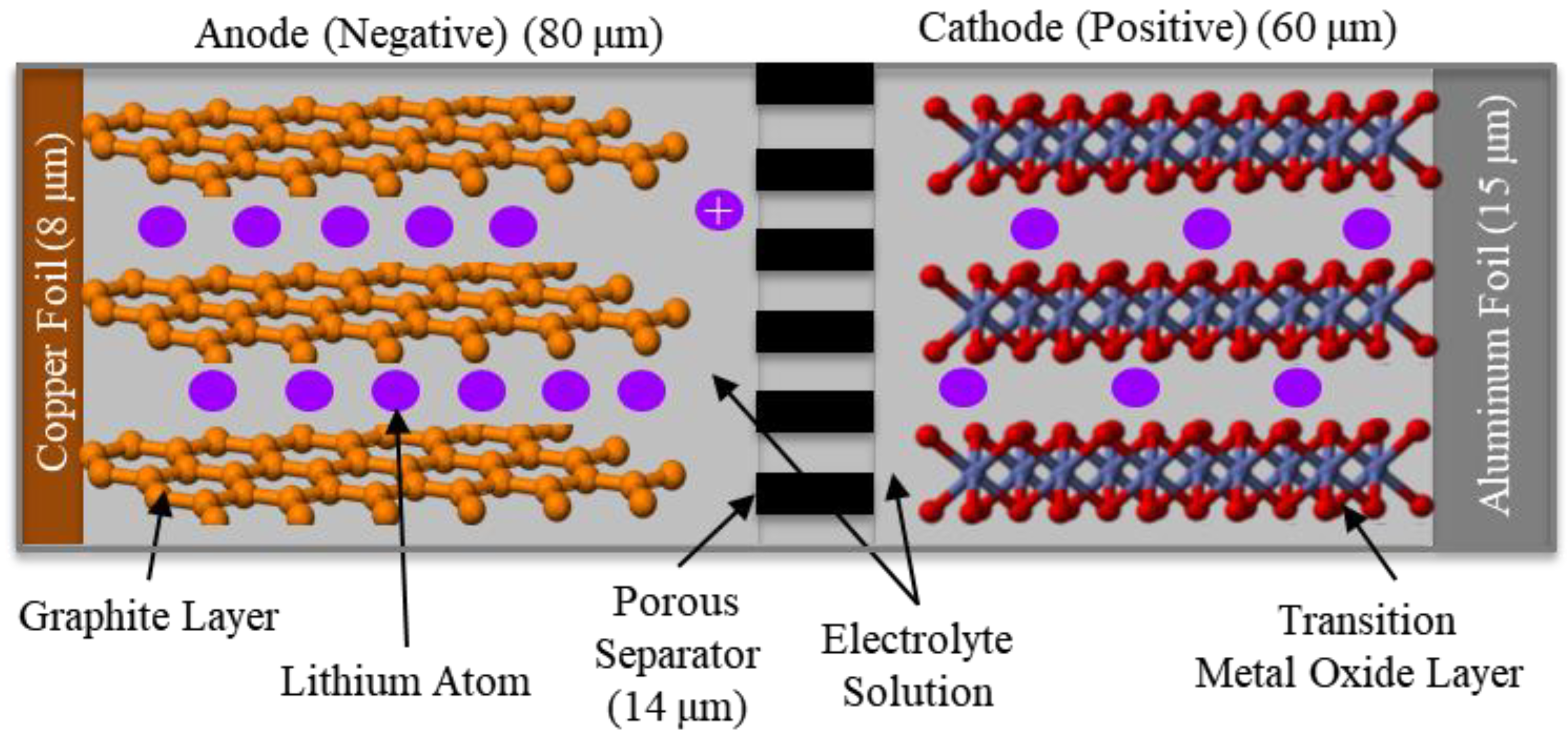

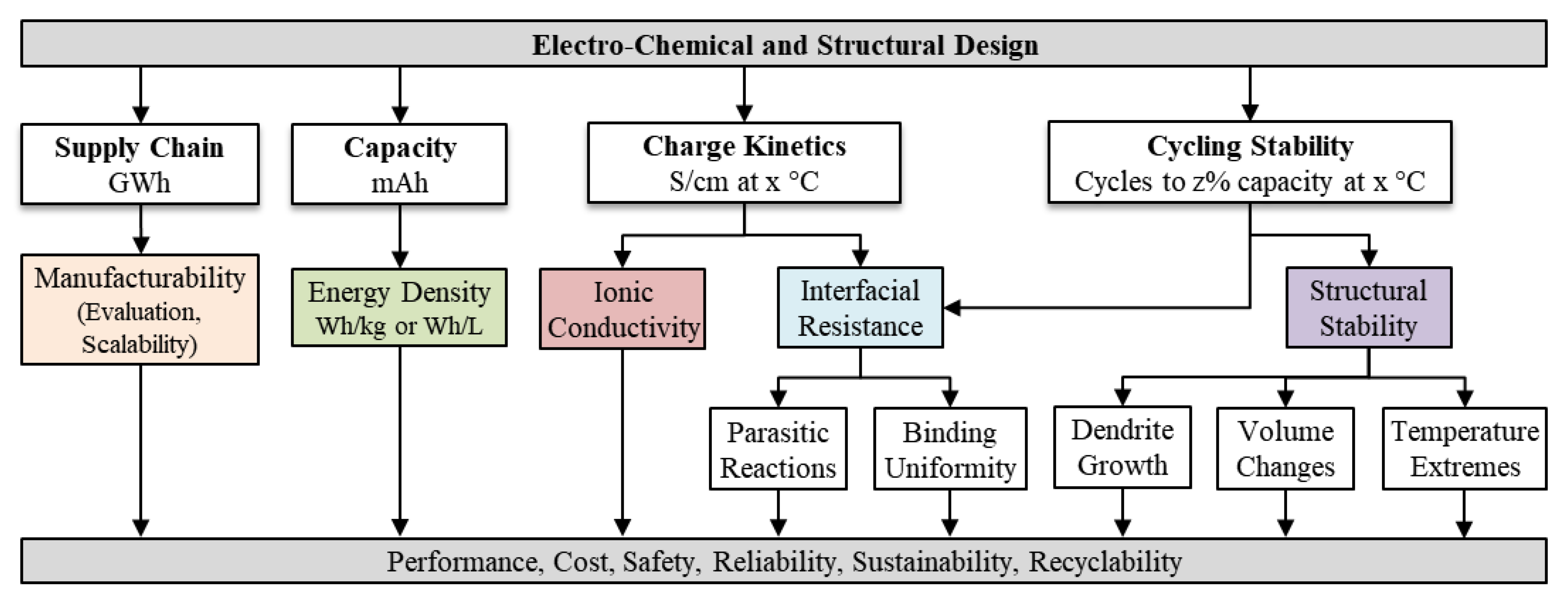
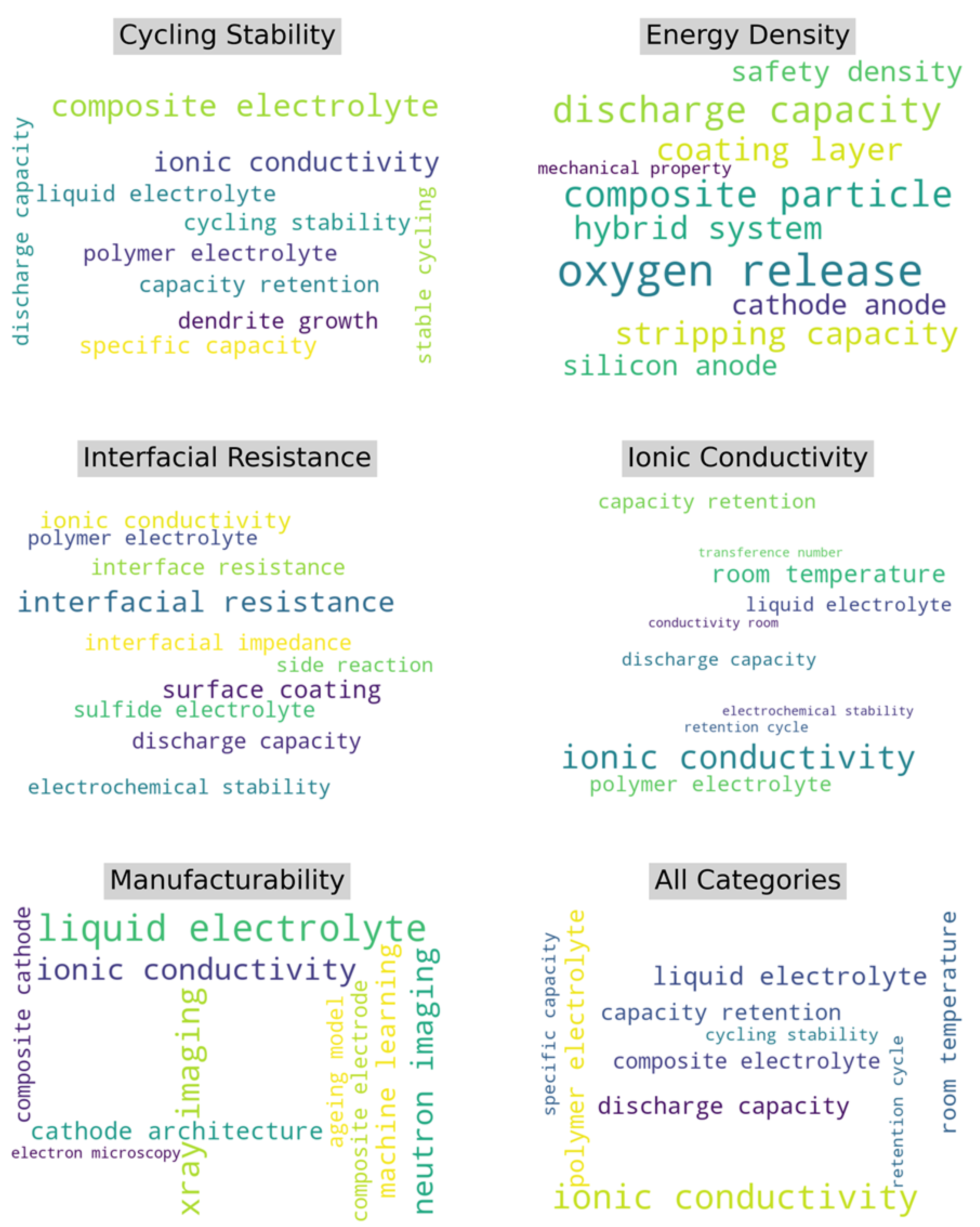
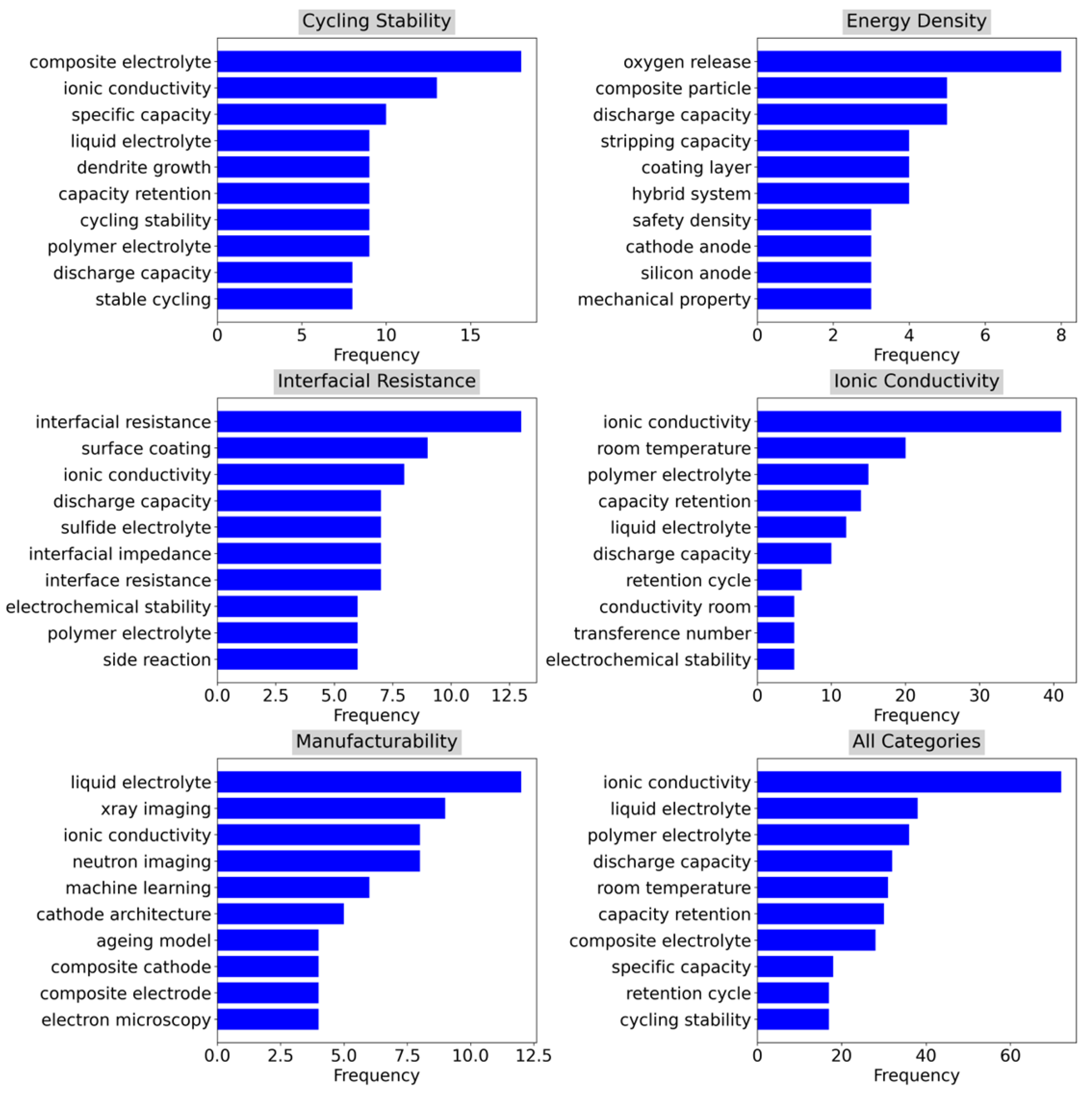


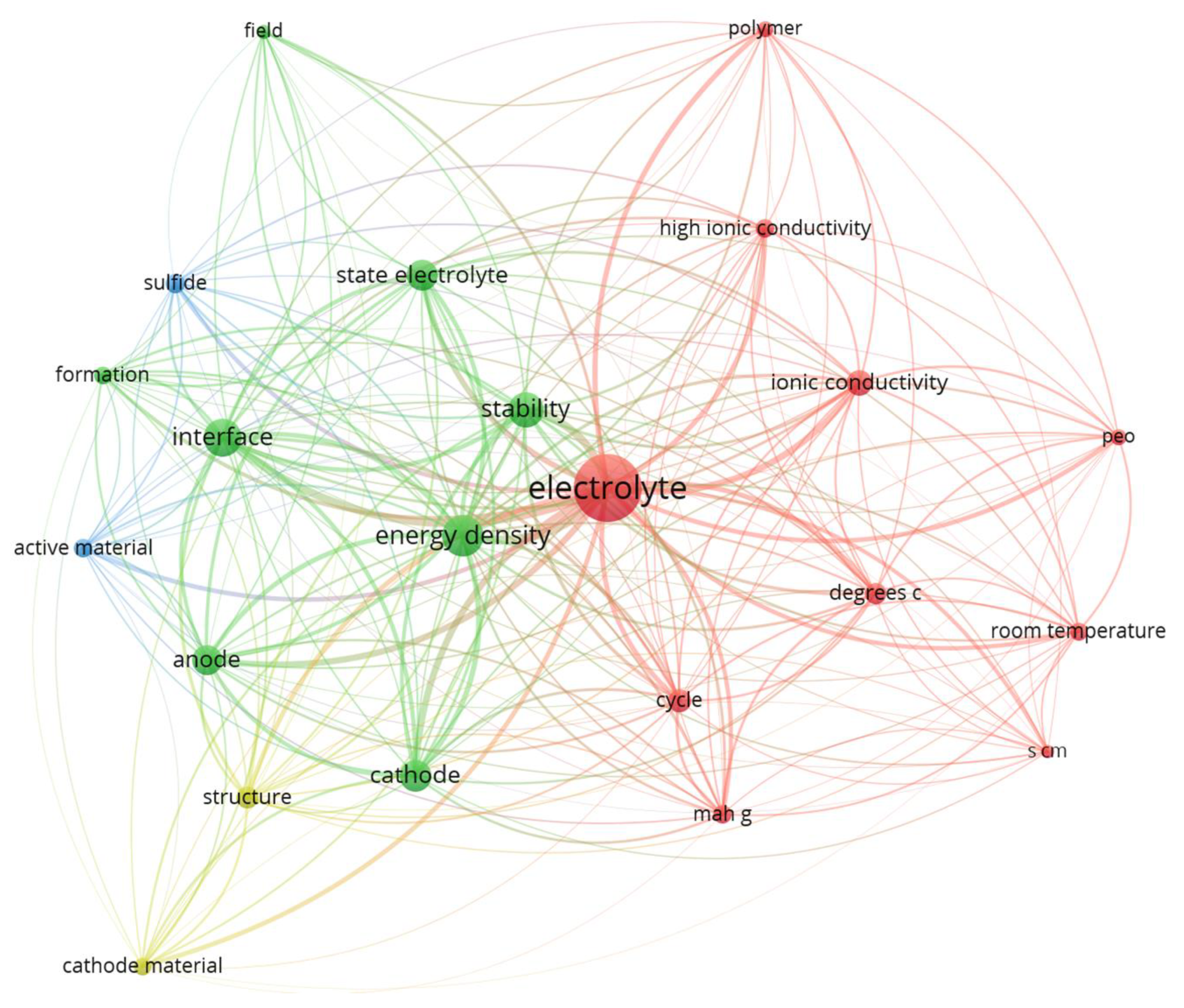
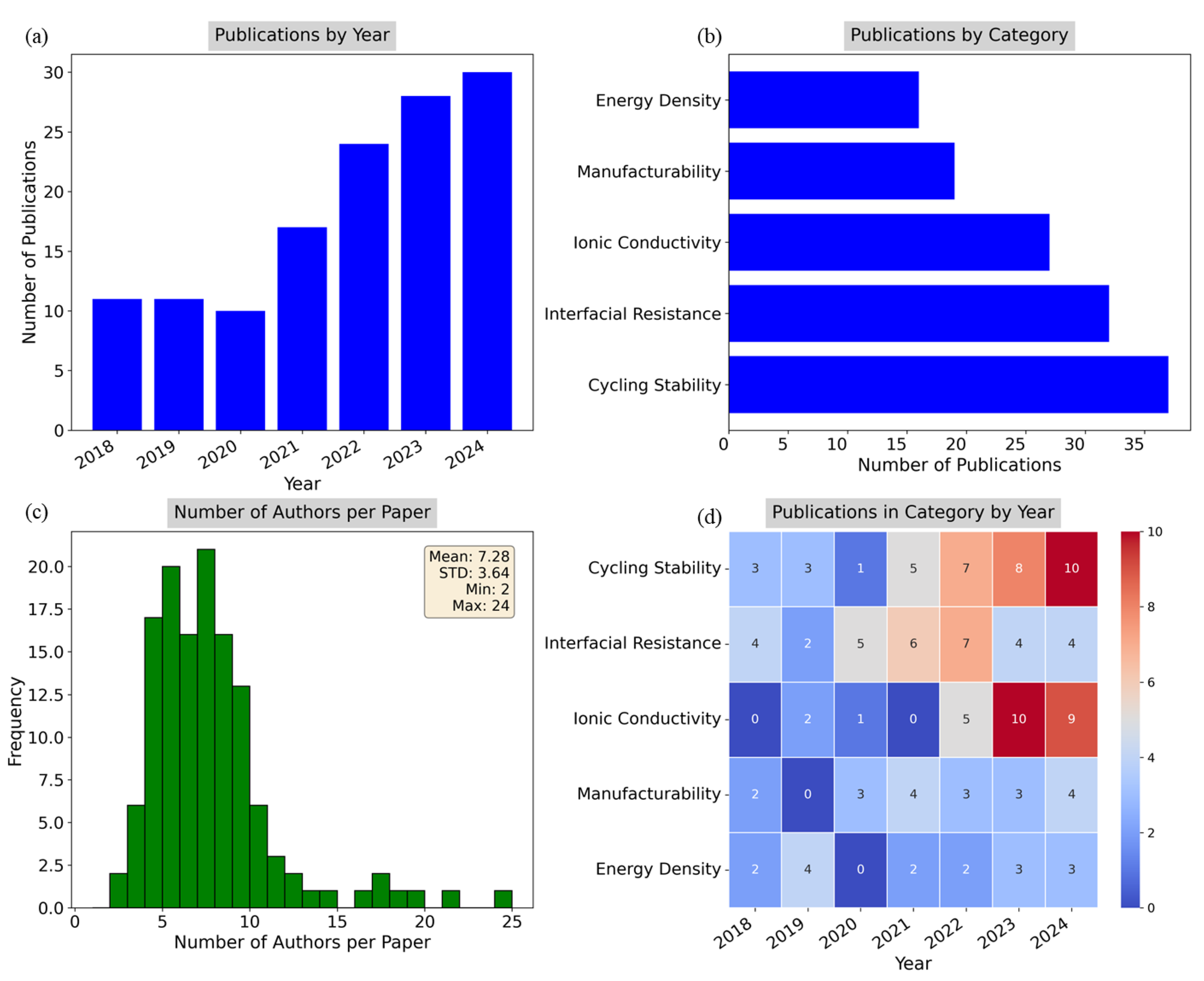
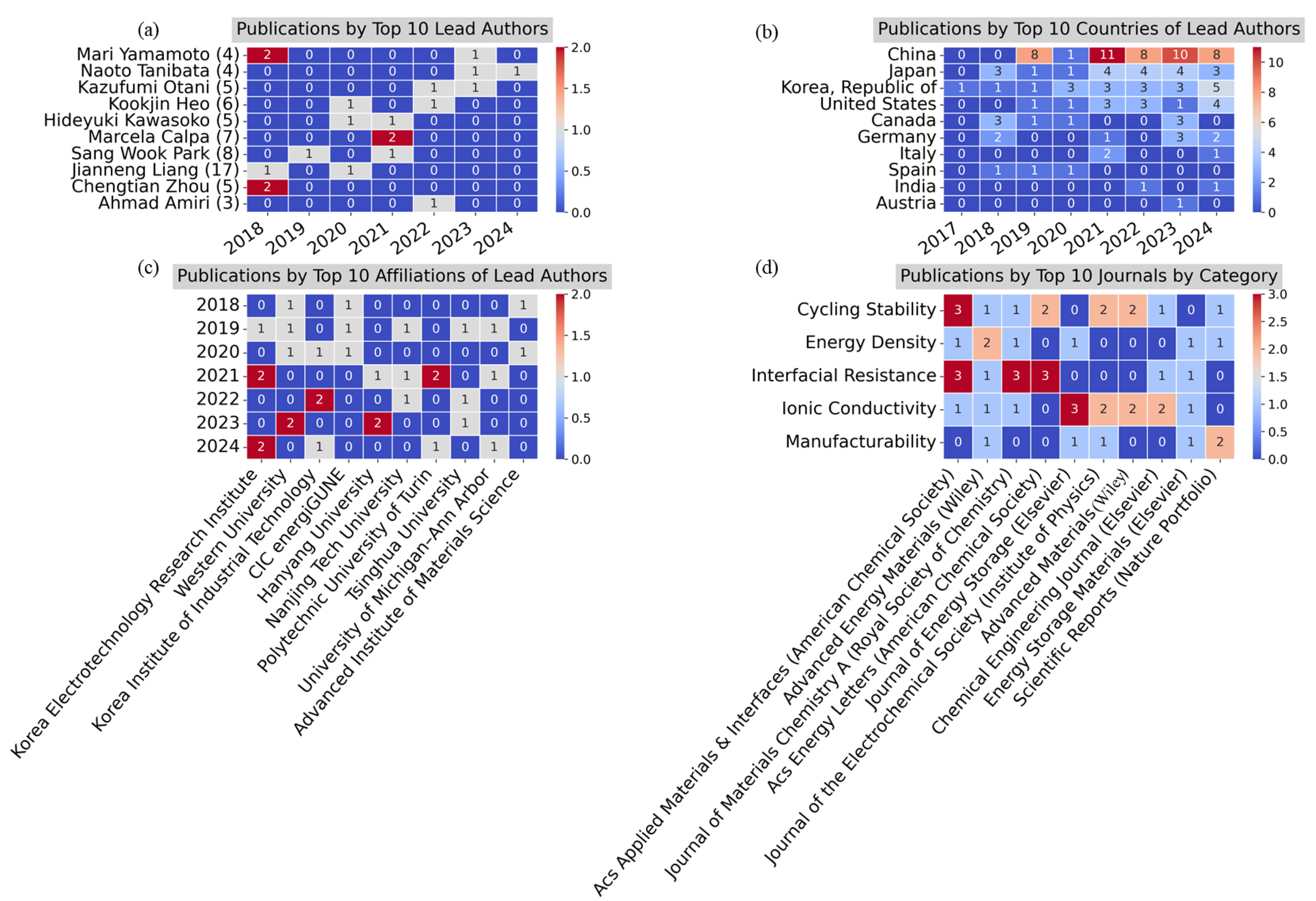




| Source | Search Command | Results |
|---|---|---|
| IEEE | (“Document Title”:“solid-state” OR “Document Title”:“solid state” OR “Document Title”:“solidstate”) AND “Document Title”:batter* AND NOT “Document Title”:transformer* | 64 |
| WOS | (TI = ((“solid-state” OR “solid state” OR “solidstate”) AND batter* NOT transform*)) AND AB = (vehicle*) | 392 |
| Google Scholar | allintitle: (battery OR batteries) AND (“solid-state” OR “solid state” OR “solidstate”) AND -transformer | 3270 |
| Country | Documents | Citations | TLS |
|---|---|---|---|
| China | 51 | 1602 | 17 |
| United States | 27 | 881 | 17 |
| South Korea | 21 | 637 | 4 |
| Japan | 20 | 378 | 3 |
| Germany | 12 | 408 | 3 |
| Canada | 11 | 632 | 8 |
| Source | Key Findings |
|---|---|
| Choi et al. (2024) [56] | Optimized wet process with sediment separation improves ionic conductivity and Li metal compatibility. |
| Song et al. (2024) [5] | Solid halide electrolyte (Li3VCl6) improves ionic conductivity and increases energy density by serving as both an active electrolyte and catholyte. |
| Xu et al. (2024) [57] | Cellulose-based eutectogel electrolyte (CETG) with dual ion conduction mechanisms improves ionic conductivity, self-healing, and cycling stability in LiFePO4 cells. |
| Sung et al. (2024) [8] | A novel, scalable wet synthesis method produces Li5.5PS4.5Cl1.5 with high ionic conductivity (4.98 mS/cm) and uniform particle size, optimizing interfacial contact and enhancing discharge capacity. |
| Zhao et al. (2024) [58] | Adding larger-grain boehmite nanoparticles to PEO-based electrolytes improves Li+ transference, ionic conductivity, and stability, enabling enhanced cycling performance in lithium metal batteries. |
| Nam et al. (2024) [59] | LTPO (LiTa2PO8) solid-electrolyte disks, synthesized via cold sintering, combined with lithium manganese iron phosphate (LMFP) electrodes, improve ionic conductivity and stability, achieving 98% capacity retention after 100 cycles at room temperature. |
| Choi et al. (2024) [56] | Separating the precipitate and removing the supernatant after high-energy ball milling increases the ionic conductivity and compatibility of solid electrolyte with lithium metal at room temperature. |
| Abe et al. (2024) [3] | A flexible PEO-based composite electrolyte with Li6.4La3Zr1.4Ta0.6O12 and liquid plasticizers achieves high lithium-ion conductivity of 6.01 × 10−4 S/cm at 25 °C while preventing dendrite formation. |
| Thomas et al. (2024) [1] | A scalable liquid-phase exfoliation process produces kaolinite nanoplatelets, enabling the creation of a nanocomposite gel electrolyte with high ionic conductivity and stability, suitable for high-rate rechargeable lithium metal batteries. |
| Kwok et al. (2023) [60] | A Li2S/LiVS2 core–shell cathode architecture improves ionic mobility, leading to good rate capability and stable capacity retention. |
| Source | Key Findings |
|---|---|
| Shao et al. (2024) [62] | TM-MES (C9H22O5Si) improves phase compatibility, ionic conductivity, and cycling performance in Li-S SSBs, achieving high energy density. |
| Cha et al. (2024) [63] | Halide-coated NCM (LiNixCoyMnzO2) electrodes reduce interfacial resistance and improve rate capability and cycling stability, with performance dependent on halide composition. |
| Terashima et al. (2024) [61] | Surface coatings, such as LiNbO3, protect NCM cathodes by mitigating side reactions, improving interface stability, and enhancing battery performance. |
| Liang et al. (2023) [64] | LLZO (Li7La3Zr2O12) coatings on LiCoO2 cathodes improve cycling performance and discharge capacity in thiophosphate-based SSBs. |
| Liu et al. (2023) [65] | A LiNbO3 coating creates a passivation layer at the cathode-electrolyte interface, reducing interfacial degradation and achieving 82% capacity retention after 2000 cycles at 1 °C. |
| Guan et al. (2022) [66] | Bending effects alleviate interfacial stress, and improving contact area and curvature enhances cell capacity and stability in flexible SSBs. |
| Tanibata et al. (2023) [67] | The Na10Sn4 metastable phase exhibits fast Na diffusivity and low interfacial resistance, enhancing battery performance. |
| Heo et al. (2022) [68] | Compositing LLZAO (Li6(.75)La3Zr2Al0.25O12) with NCM811 (LiNi0.8Co0.1Mn0.1O2) cathode reduces interfacial resistance and improves cycling stability and rate performance. |
| Saffirio et al. (2022) [69] | The addition of diboron trioxide (B2O3) improves grain cohesion, reduces grain boundary resistance, and enhances ion mobility, making the glass-ceramic based on Li1.4Al0.4Ge0.4Ti1.4(PO4)3 solid-state electrolyte promising for high-energy density, safe lithium-based batteries. |
| Zhao et al. (2022) [70] | A SnS2 ultra-thin film on LLZTO (Li6.75La3Zr1.75Ta0.25O12) forms a Li2S/LixSn conductive layer through a conversion reaction with molten Li, reducing interfacial impedance and inhibiting dendrite growth. |
| Source | Key Findings |
|---|---|
| Zhu et al. (2024) [72] | Doping a lithium aluminum titanium phosphate (LATP) solid-state ceramic electrolyte with zinc strengthened its mechanical properties while providing an optimized network channel for lithium-ion transport at room temperature. |
| Kreissl et al. (2024) [73] | Fe-substitution in SnO2 and ZnO anodes enhances cycling performance by mitigating degradation in Li6PS5Cl-based SSBs. |
| Ma et al. (2024) [74] | Oxyhalide-nitride solid electrolytes (ONSEs) exhibit high dendrite-suppression capabilities, improved thermodynamic stability, and enable long-term cycling, achieving 90% capacity retention over 500 cycles. |
| Jiang et al. (2024) [75] | Bi-O dual-doping in Li5.5PS4.5Cl1.5 electrolyte improves air/moisture stability, enhances Li dendrite suppression, and accelerates Li-ion transport. The resulting electrolyte, Li5.54P0.98Bi0.02S4.47O0.03Cl1.5, achieves superior cycling performance with a Li metal anode, retaining 79.7% capacity after 150 cycles at 25 °C using LiCoO2 and high-nickel cathodes. |
| Zhou et al. (2024) [76] | A conductive S9.3I molecular crystal with iodine insertion enhances electrical conductivity and enables interface repair through remelting, improving cycling stability and capacity retention. |
| Kim et al. (2024) [7] | Substituting lithium with cadmium in the solid electrolyte induces structural distortion and enhances stability, significantly improving critical current density and cycling performance. |
| Lu and Birke (2024) [77] | A dual-layered anode with a thin zinc layer (286 nm) and carbon black improves cycling stability and discharge capacity retention by optimizing lithium-zinc alloying behavior. |
| Kim et al. (2023) [78] | B doping and coating of a Ni-rich cathode improves microstructure and interface stability. |
| Li et al. (2023) [32] | Precise tailoring of Li-ion transport in Li3InCl6 halide solid electrolytes boosts lithium-ion conduction and dendrite suppression, significantly improving cycling life and capacity retention. |
| Du et al. (2022) [79] | A flexible SSB with a V2O5 nanowire–carbon-nanotube composite cathode and silver nanowire/lithium composite anode enhances cycle stability and inhibits Li dendrite growth, achieving stable performance over 500 cycles. |
| Source | Key Findings |
|---|---|
| Han et al. (2024) [80] | A core–shell approach using Li6PS5Cl and LiNbO3 coatings on LiNi0.8Mn0.1Co0.1O2 particles enhances cathode active material utilization, resulting in improved ionic conductivity and a dense microstructure. This design achieves a reversible capacity of 197 mAh/g and excellent cycling performance with 86.3% retention after 1000 cycles at 2 °C. |
| Lee and Sakamoto (2024) [71] | Surface modification of garnet electrolytes and intermittent current stripping improve stripping capacity and suppress void formation in Li by 40%. |
| Tanibata et al. (2024) [81] | NaFeCl4, with a high redox potential and deformability, offers improved energy density and safety. |
| Xiong et al. (2023) [82] | High-concentration PEO electrolytes resist oxidation and improve cycling stability with high-voltage cathodes and enhance energy density. |
| Poetke et al. (2023) [83] | Partial lithiation of silicon microparticles with reduced charge cut-off potential improves capacity retention and energy density in NCM cells. |
| Hayakawa et al. (2022) [84] | Incorporating acetylene black into the SE coating layer improves cell capacity and rate performance. |
| Xu et al. (2019) [85] | SSBs with Li7P3S11 electrolyte, silicon anode, and Li2S/graphene cathode achieve high energy density and improved safety without using metallic lithium. |
| Martinez et al. (2019) [86] | A catholyte fraction of 30–40% ensures good interfacial contact and ionic transport, enabling theoretical energy densities up to 185 Wh/kg and 345 Wh/L. |
| Wang et al. (2019) [87] | Lithium-depleted Li0.33MnO2 is a cost-effective, cobalt-free cathode material, offering improved cycling stability by reducing manganese dissolution and enhancing gravimetric energy density. |
| Huang et al. (2018) [88] | A graphene-based quasi-solid-state lithium–oxygen battery with a 3D porous graphene cathode, a redox mediator-modified gel polymer electrolyte, and a porous graphene/Li anode overcomes key challenges, achieving higher gravimetric and volumetric energy densities than commercial Li-ion polymer batteries. |
| Source | Key Findings. |
|---|---|
| Choi et al. (2024) [4] | Dual-doped sulfide electrolyte improves air stability, ionic conductivity, and Li metal compatibility towards scalable manufacturing. |
| Wach et al. (2024) [91] | Laser cutting technology improves the edge quality of sulfide-based components, advancing the production process for SSBs. |
| Basak et al. (2023) [92] | Using in situ transmission electron microscopy on Si nanoparticles enables efficient screening of potential coatings to improve interface stability in SSBs. |
| Cao et al. (2023) [89] | Neutron imaging provides nondestructive operando visualization of Li dynamics and reaction mechanisms, offering insights towards SSB manufacturing. |
| Yoon et al. (2022) [93] | Storage at 70 °C causes significant degradation of Li6PS5Cl, leading to SOx gas evolution, porous cathode/electrolyte interfaces, and increased interfacial resistance, highlighting the need to reassess solid electrolyte stability. |
| Song et al. (2022) [94] | Controlling particle size of Ni-rich NCM811 cathodes improves electrochemical performance in SSBs with composite solid electrolytes. |
| Lou et al. (2021) [90] | Synchrotron X-ray imaging provides real-time insights towards manufacturing SSBs. |
| Ge et al. (2021) [95] | A novel green solid polymer electrolyte made from ionic liquid-based waterborne polyurethane and LiClO4 achieves high conductivity without the use of organic solvents, offering a safe and eco-friendly alternative for SSBs. |
| López-Aranguren et al. (2020) [96] | NMC622 cathode with PEO-based electrolyte and Li metal anode delivers 91% of theoretical capacity, demonstrating feasibility for industrial-scale SSB development. |
| Zhang et al. (2019) [97] | In situ electrochemical impedance and Raman spectroscopy show that Li+ ion migration, varying with potential change, significantly impacts the interface, contributing to SCL, interfacial reactions, and long-term deterioration of electrochemical performance. |
Disclaimer/Publisher’s Note: The statements, opinions and data contained in all publications are solely those of the individual author(s) and contributor(s) and not of MDPI and/or the editor(s). MDPI and/or the editor(s) disclaim responsibility for any injury to people or property resulting from any ideas, methods, instructions or products referred to in the content. |
© 2024 by the author. Published by MDPI on behalf of the World Electric Vehicle Association. Licensee MDPI, Basel, Switzerland. This article is an open access article distributed under the terms and conditions of the Creative Commons Attribution (CC BY) license (https://creativecommons.org/licenses/by/4.0/).
Share and Cite
Bridgelall, R. Scientometric Insights into Rechargeable Solid-State Battery Developments. World Electr. Veh. J. 2024, 15, 555. https://doi.org/10.3390/wevj15120555
Bridgelall R. Scientometric Insights into Rechargeable Solid-State Battery Developments. World Electric Vehicle Journal. 2024; 15(12):555. https://doi.org/10.3390/wevj15120555
Chicago/Turabian StyleBridgelall, Raj. 2024. "Scientometric Insights into Rechargeable Solid-State Battery Developments" World Electric Vehicle Journal 15, no. 12: 555. https://doi.org/10.3390/wevj15120555
APA StyleBridgelall, R. (2024). Scientometric Insights into Rechargeable Solid-State Battery Developments. World Electric Vehicle Journal, 15(12), 555. https://doi.org/10.3390/wevj15120555







